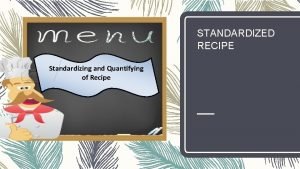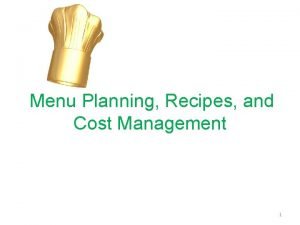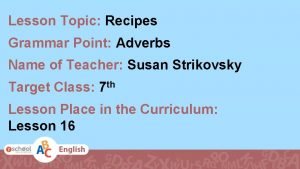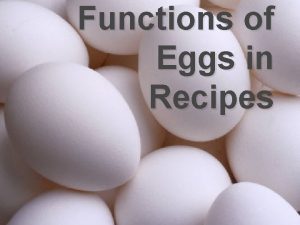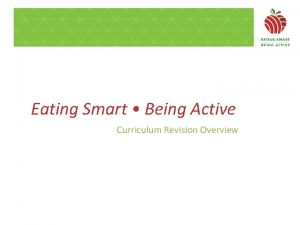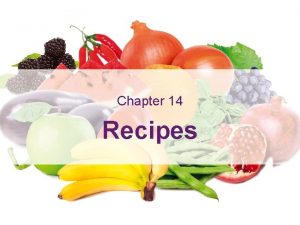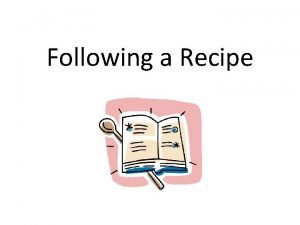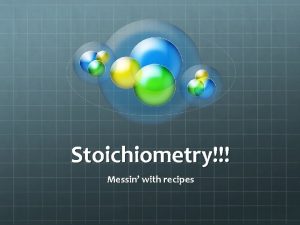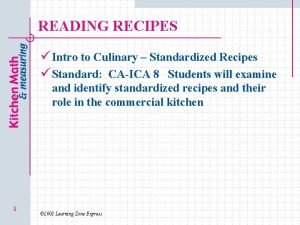Recipe Language Recipes have a language all their








- Slides: 8

Recipe Language Recipes have a language all their own. This language is made of terms that describe exactly how to prepare, combine, or cook ingredients.

Culinary Language • Abbreviation> A shortened form of a word. • Example – C = Cup – Tsp. = teaspoon – Tbsp. = tablespoon Measurements • Why does the success of recipes depend upon accurate measurements? • Success with recipes depends on accurate measurements. If the measurements are off, even the best recipe won’t look and taste good? • Measurements matters!!

Standard Measurement equivalents • • 3 teaspoons = 1 tablespoon 16 tablespoons = 1 cup 2 cups = 1 pint 2 pints = 1 quart 4 quarts = 1 gallon 8 fluid ounces = 1 cup 16 ounces = 1 pound • Knowing equivalent amounts makes it easy to adjust recipe yields.

Ingredients amounts • The amount of each ingredient you need may be given as units, weight, or volumes • Units tell you how many of an ingredient you should use. • Weights tell you how heavy an ingredients should be (restaurants list ingredients weight because it is easier for chefs to weigh lbs than cups) • Volume is the space an ingredients occupies. A cup of flour and a liter of milk are volume measurements

Dry ingredients • Dry ingredients are measured using measuring spoons or dry measuring cups – Fill the measuring cup or spoon with ingredient – Drag the straight edge over the cup or spoon to level off the ingredient Liquid ingredients • Liquid ingredients are measured using liquid measuring cups. Small amounts are measured with measuring spoons. • Place the liquid measuring cup on a level surface • Bend down and look at the measurements written on the side of the measuring cup • Be sure to bend down to read measurements if you lift the cup up to check the amount of liquid, the cup will tilt.

Recipe language terms • Stir, slice, grate, grind, mince, grease, preheat, sift, baste, drain, scrape, pare, peel, julienne, shred, cube, chop, puree, fold, knead, mix, blend, beat, cream, whip & cut in

Key terms • Grease> To rub or spray lightly with fat or oil • Puree> To grind or mash food until it becomes smooth and liquid • Baste> To moisten foods during baking or roasting with fat, juice, or sauce • Knead> To press and fold a ball of dough with the heels of your hands until the dough is smooth and elastic • Stir> To Slowly move a spoon in a circle to combine ingredients • Fold> To gently combine ingredients. • Whip> To beat rapidly with a wire whisk, beater or mixer in order to make a mixture smooth and fully • Cream> To beat sugar and a solid fat, such as butter, together until they are smooth and light • Cut in> to combine solid fat, such as shortening, with a flour mixture by cutting the fat into tiny pieces with a pastry blender

Key Terms • Blend> to mix ingredients until they are very smooth • Julienne> To cut into long, thin strips the size of matchsticks • Chop> to cut into small, uneven pieces • Mince> To cut into very small pieces • Sift> To put dry ingredients through a flour sifter or fine sieve • Pare> To cut off outer skin with a knife or vegetable peeler



